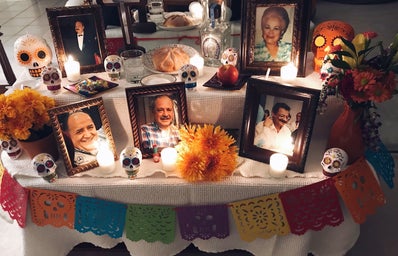Halloween
Halloween is one of the most famous global holidays, symbolized by ghosts and scary creatures roaming around and trick or treating. It originated from the celebration of the Celtic tribes who used to inhabit the land that is now Ireland, United Kingdom, and Northern France. Having their new year’s day on November 1, the Celts celebrated Samhain (pronounced as sow-in) on the last day of the year. They believed that on October 31, the worlds of the dead and living open up and ghosts return to the Earth bringing all sorts of misfortune, including death. This belief most probably arose as the transition from fall to winter brought upon the death of crops and those who could not survive the harsh winter. This emphasized the dark and ominous atmosphere of Samhain, which aimed to ward off any ghost with ill intentions. Records say that the Celts started the tradition of wearing costumes made of animal heads and skin for the celebration, partly to protect themselves from the malicious spirits and also to tell each other their fortunes through the energy of otherworldly spirits around them.
However, the conquest of the Roman Empire over the Celtic territory stirred a religious mixture to the original celebration of the Celtics. Two Christian festivals, Feralia (commemoration for the passing of the dead) and the honoration of Pomona (the Roman goddess of fruit and trees), were incorporated in the Samhain, completely changing the meaning of the celebration.
At a later period during colonization, Pope Gregory III expanded the Christian All Martyrs Day to All Saints’ Day and set it to November 1 from its previous observance in mid-May. Thereafter, the church established All Souls’ Day on November 2nd to commemorate the dead- which many see as an attempt to shift the non-religious holiday Samhain into a church-affiliated one. The modern name of Halloween comes from a shortcut of “All-Hallows eve”, with hallow meaning holy, alluding to the commemorated Saints of November 1. These events make up Halloween, a collaboration of the Celts’ tradition and Christian beliefs.
Dia de los Muertos (Day of the Dead, Mexico)
Mexico is unofficially a Catholic country with over 80% of its citizens being Catholics. However, the active traditional practice for the dead had been practiced within the country long before the introduction of the religion. Mexicans gave great meaning to maintaining ties with the deceased and kept them close to the family -literally. Long ago, Mexicans buried the dead in tombs underneath the central patio of their homes. When the Day of the Dead came, they decorated their homes with Marigold and sugar skulls to welcome the spirits on October 31 and November 1. With the creation of cemeteries, Mexicans extended their decorations to the deceased’s’ grave and celebrated the night in cemeteries. The spread of Catholicism included the message of All Saints’ Day and All Souls’ Day into the celebration, but not much has changed in the mode of celebration. Contrary to the Celtic origins of Halloween, celebrating the death has always come in a festive manner for Mexicans. Today, Mexicans are also starting to celebrate the modernized Halloween, alongside Dia de los Muertos.
Upon researching about the two most renowned holidays for the dead, I could not help notice the different nature of the Western and Eastern cultures. Perhaps due to the popularity of Buddhism over Catholicism and geographical differences, countries in Asia that hold similar celebrations usually do it under the general name of “Thanksgiving” at the beginning of Autumn. While some Western countries hold Thanksgiving with families as well, this celebration serves as a time to revisit ancestral graves and thank them (or ask them, in some cultures) for a bountiful harvest of the year and offer them the first harvests in many Eastern cultures. For many families in South Korea, Chuseok is the general celebration meant to thank the older ancestors of the family. Separate celebrations for each departed close family member is celebrated on their death anniversary. Usually a sumptuous meal is prepared according to tradition, and family members gather to pay their respect then consume the prepared food.
It’s fascinating to see the different ways each culture puts into preparing a day for the dead and what it means to them. Now that the Halloween festivities are coming to a close for the year, I can officially move forward to celebrating and understanding the upcoming festivities (off to Christmas now!).


